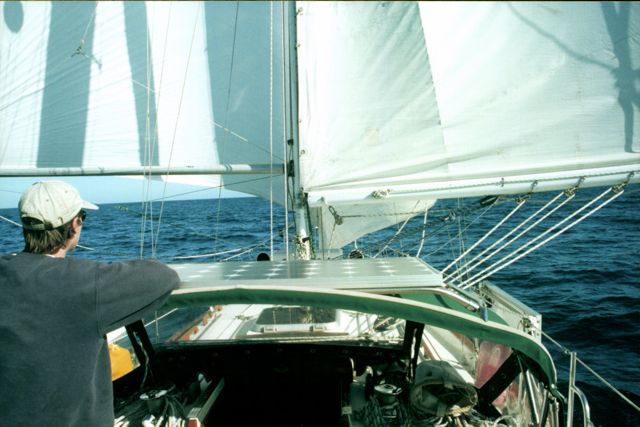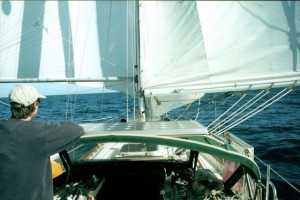Wind, sun, and dinosaurs

You may have noticed that we have a lot of decisions to make regarding equipment on Shearwater. For every decision, there are usually a number of possible solutions, and each solution comes with a few compromises such that the choice is rarely clear. I take the opportunity when I can to write about the options. I try to paint a vivid picture (for myself) of what each option really offers and what the drawbacks are, and hopefully after putting everything down on paper, the choice will become more or less obvious. If not, well at least I can keep referring back to the post, and I get to practice writing.
Recently, I got to thinking about how we are going to recharge our two brand-new, super-awesome 400ah 6V Mastervolt AGM batteries. We’ll tell you about that decision later… Anyway, we have a few legitimate choices to recharge our batteries. The obvious candidate is using the alternator on the diesel. Sure, whenever, the diesel is on, we want it to be charging the batteries, but it is fair to say right here at the beginning that I despise running the engine for the sole purpose of charging the batteries. It is seems like such a waste of fuel, but generates additional noise, pollution, and wear on the engine, particularly since the engine is not under much load just charging batteries. In fact, I despise running the engine, period, but that is the subject of another (or several other) posts. Goal number one for recharging is minimizing the amount of time the engine must run to recharge the batteries. We do that two ways. First, we reduce the draw on the batteries, and second, we increase the generating capacity when the engine is on. Reducing the electrical draw is worth a post by itself. (Yes, I’ve already identified 3 more posts that we need to write, and I am only 300 words into this one!) Increasing generating capacity turns out to be a fairly straightforward decision. We need a bigger alternator. The stock 55-amp Hitachi alternator and internal regulator is both low on oomph and low on smarts. Our existing alternator doesn’t generate much energy, and it also doesn’t do it particularly efficiently or in a manner that is healthy for the batteries. Enter a new Balmar 110-amp alternator and ARS 5 voltage regulator. More oomph and more smarts. 110-amps seems to be about the largest alternator you can run off of one belt, and I couldn’t justify going to a more complicated and more expensive 2 belt system since, really, I’d rather not run the engine at all. The new alternator awaits installation in April, and we’ll keep the stock alternator aboard as a backup.
Besides burning dinosaurs to make electricity, how else can we put of the juice back in the batteries? With the wind and the sun, of course! Actually we could also use a towed water generator or a fuel cell, but neither of those options seem like real candidates since the towed generator requires the boat to be moving while adding drag, and the fuel cell is really cool, but currently darn expensive. Maybe in a few more years? The wind and the sun offer promising and proven alternatives, however. Solar panels have proven themselves pretty reliable on boats, and the price has come down tremendously in the last 10 years. We had 3 panels on Earendil totalling 165 watts. That worked really well for us in Southern California and Mexico. To start things off on Shearwater, we are going to get something like a single 140 -watt Kyocera that we will mount on top of dodger. 140 watts gets us roughly 10 amps at maximum output, which is rare, but averaging 4 amps for 12 hours during a sunny day might be realistic. I think the dodger on Shearwater will be wide enough, but since it is currently under construction we’ll need to measure it first to make sure the monster 140 watt panel will fit. Here’s hoping! There isn’t much downside to a solar panel on a boat. The biggest drawbacks we can see is that it is difficult (and generally not worth the effort) to keep a solar panel perpendicular to the sun’s rays and things like sails and rigging often block a portion of the panel, dramatically reducing the output. Even with those caveats, a solar panel, for the price, makes a lot of sense.
And then there is wind. Say, don’t you (meaning me) work in the wind industry? Why yes, I do. The company I work for builds really big wind farms using really big wind turbines. It would seem almost sacrilegious to not consider a wind generator for Shearwater. So, I will. 10 years ago, I wasn’t so impressed with wind generators for boats. They were noisy and required a fair bit of wind to generate any real power. Most of us seek out the least windy spot we can find when anchored, and when underway we do our best to sail downwind, which reduces the apparent wind speed the wind generator would see. Fortunately, technology has continued to march forward, and now there seems to be a wind turbine that is both quiet and able to generate decent power at moderate wind speeds. From what we have heard, the D400 made in the UK is that turbine. At 10 knots it is supposed to put out about 3 amps, and at 15 knots it should produce 9 amps. Of course, it just keeps producing more above 15 knots, but really how often will we see that wind speed (on purpose)? That said, even with an average wind speed of 10 knots the D400 can produce almost twice as much energy each day as the solar panel. The bonus, of course, for a wind turbine is that it can produce day and night and provides diversity of resources when paired with a solar panel. I like that diversity a lot. The downside of the D400 is that it is quite expensive and needs a tall sturdy pole for mounting, which means it is not so easy to install. Nonetheless, the D400 is on our wish list, even if we don’t spring for one right away.
With a 140-watt solar panel and the D400, figuring an average of 10 knots of wind, we could put 120 amps back into the batteries. That may fall short of our daily usage, but it should reduce the need to use the engine down to every 5 days or so, and when we are actively cruising, we would likely run the engine for propulsion during that period anyway. Maybe one more solar panel (a flexible panel?) mounted on the spray hood in front of the dodger would complete the system?

You can see the solar panel mounted on the dodger on Earendil and the smaller solar panel (x2) mounted to stanchion.
Sign up to receive blog updates
Leave a Reply